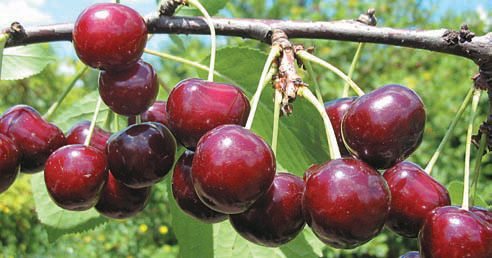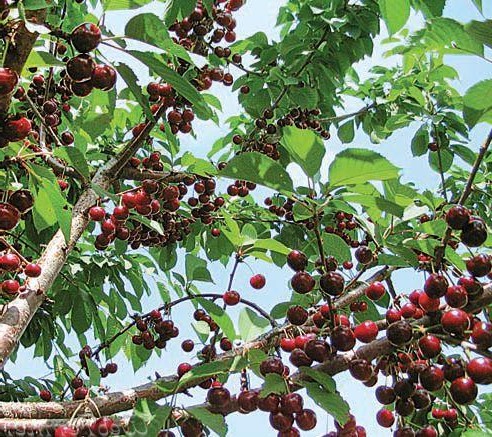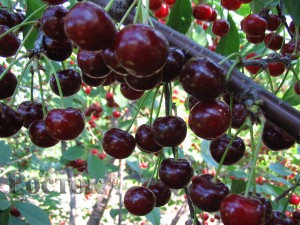- Description of Duke
- Growing duka, a hybrid of sweet cherry and cherry.
- Duke varieties
Description of Duke
Cherry - sweet cherry is a hybrid of cherry and sweet cherry obtained by breeders. Its biological name is duke. Dukes inherited all the best from their parents.
The large duki fruits (9-15 g) have a pleasant taste, the trees are productive and resistant to many diseases and pests. The average yield is 10-15 kg per tree. They begin to bear fruit in the 3-4th year.Frost-resistant, tolerate 25-degree frost.
But all varieties of dukes are self-sterile. For pollination they need only cherries; they often do not accept cherry pollen.
If there are few varieties of cherries and cherries in the country, the dukes may not find a pollinator and will produce a very low yield. For example, if you have a Miracle cherry growing, and next to it is a Julia cherry, then there will not be a big harvest, because Julia does not pollinate the miracle cherry.
If duke (or other stone fruits) are sprayed with poisons before flowering, pollinating insects will also die.
Growing duka, a hybrid of sweet cherry and cherry
A hybrid of sweet cherry and sour cherry (duke) is grown in fertile, slightly acidic soils. It is advisable that the site be protected from strong winds and well lit by the sun. Duke grows poorly in lowlands, where water accumulates in summer and cold air in winter.
All varieties of dukes are self-sterile. They only need cherries for pollination.
In order for this hybrid to bear fruit well, it is necessary to ensure proper cultivation of the duke. This crop does not particularly need fertilizing; it is enough to dig up the trunk circles in the fall and mulch them with grass and dry leaves.
Dukes bear fruit on bouquet branches - shortened fruit formations (0.5-5 cm), located mainly at the top. They consist of a group of buds, in which the lateral buds are generative (fruiting), and the terminal buds are vegetative (growth). At the same time, the formation of shoots is weakened.
When growing sweet cherries, gardeners noticed that duka trees grow strongly before they begin to bear fruit. And when they begin to produce crops, growth weakens. In this regard, the nature of pruning changes.
Duke trimming. Proper pruning is of great importance for growing duke.The first annual growths should be shortened by 1/5-1/6 of the length of the shoot.
The main task of spring pruning of fruiting dukes is to maintain the necessary growth of branches. When the growth weakens to 10-20 cm, it is necessary to carry out light anti-aging pruning: shorten the branches along the entire crown to 3-4-year-old wood. This operation is repeated every 5-6 years.
In the first year, shortening the branches will cause a slight reduction in yield. But the next one levels out, and in subsequent years it rises due to the growth of numerous side shoots.
After shortening the annual branch by 1/5-1/6 of the length, you need to remove the competitor branch with an acute angle of departure (less than 45 degrees), cut the central conductor by 40 cm so that bouquet branches are formed at the base.
The lateral branches of dukes are pruned depending on the angle of departure (from the trunk): the greater the angle of departure, the weaker the pruning. The lateral branches with an angle of 90 degrees are not shortened, but pinched, removing the apical bud. Then more bouquet branches are formed.
To form a larger number of bouquet branches at the base of the branches, pruning on a side branch is used. This changes the direction of the branches.
The crown of the dukes should not be allowed to thicken, and thinning should be applied periodically.
The main attention should be paid to the correct placement of branches, subordination and prevention of the formation of sharp forks.
All sections, incl. on annual branches of dukes, cover with garden varnish or rannet paste, or oil paint on natural drying oil, so that pathogens do not penetrate into the wounds after pruning. In all other respects, growing duka is similar to growing cherries.
Watering cherries. Like other stone fruits, dukes do not tolerate excess soil moisture. Frequent watering causes gum production, cracks in the trunk and skeletal branches.
To maintain optimal soil moisture, mulch the tree trunk circle with mowed dried grass and seedless weeds.
First remove the weeds, water the soil and only then spread the mulch. Dry soil cannot be mulched, as this slows down the flow of water to the roots. If you do not mulch the soil, be sure to loosen it after watering. With good growth (40-60 cm), at the end of May, sow green manure in the spaces between the rows. But the tree trunk circle should remain under black fallow.
Winter hardiness of dukes
Gardeners are very concerned about the winter hardiness of dukes. According to breeders, the winter hardiness of dukes is close to that of cherries and is noticeably higher than the winter hardiness of cherries. All varieties of cherries are recommended for cultivation in the Central Black Earth Region. In more northern regions, harvests are not regular, but in general, growing dukes is possible there too.
Duke varieties
Spectacular, Surprise. The varieties are very similar, with an average ripening period. The fruits are dark red or red, weighing 6 - 8 g. The taste is sweet and sour with a cherry aroma.
Disadvantages: Trees are susceptible to sunburn in winter and are therefore short-lived. For the winter, it is necessary to tie the trunks and bases of skeletal branches or whitewash them.
Excellent Venyaminova. The fruits are large, weighing 6 - 8 g, sweet and sour, red in color.
Mid-late ripening.
Miracle - cherry. This is the most famous variety, which is most often found on sale. Among other dukes, Miracle - cherry is closest to cherry.The fruits are very large, weighing 9 - 10 g, dark red, flat-round, with a sweet and sour taste. An early variety that requires warmth.
The winter hardiness of this variety is significantly lower than that of other varieties. It is recommended to grow this duke only in the southern regions; in addition, it has problems with pollination.
Dorodnaya, Nochka, Pivonya, Ivanovna, Fesanna. These varieties are similar to each other, the fruits are large, weighing 7 - 9 g, dark cherry, the flesh is dark cherry or red.
The Fesanna variety is inferior in winter hardiness to other varieties of this group. This duke is best grown in the south of the Central Black Earth Zone.
Donetsk spanka. This variety has large pink fruits with yellow flesh. It is distinguished by its unusually high yield and the fact that it is the only duke that is self-fertile.






 (1 ratings, average: 4,00 out of 5)
(1 ratings, average: 4,00 out of 5) CUCUMBERS NEVER GET SICK, I'VE BEEN USING ONLY THIS FOR 40 YEARS! I SHARE A SECRET WITH YOU, CUCUMBERS ARE LIKE THE PICTURE!
CUCUMBERS NEVER GET SICK, I'VE BEEN USING ONLY THIS FOR 40 YEARS! I SHARE A SECRET WITH YOU, CUCUMBERS ARE LIKE THE PICTURE! You can dig a bucket of potatoes from each bush. Do you think these are fairy tales? Watch the video
You can dig a bucket of potatoes from each bush. Do you think these are fairy tales? Watch the video
 How our fellow gardeners work in Korea. There is a lot to learn and just fun to watch.
How our fellow gardeners work in Korea. There is a lot to learn and just fun to watch. Eye trainer.The author claims that with daily viewing, vision is restored. They don't charge money for views.
Eye trainer.The author claims that with daily viewing, vision is restored. They don't charge money for views. A 3-ingredient cake recipe in 30 minutes is better than Napoleon. Simple and very tasty.
A 3-ingredient cake recipe in 30 minutes is better than Napoleon. Simple and very tasty. Therapeutic exercises for cervical osteochondrosis. A complete set of exercises.
Therapeutic exercises for cervical osteochondrosis. A complete set of exercises. Which indoor plants match your zodiac sign?
Which indoor plants match your zodiac sign? What about them? Excursion to German dachas.
What about them? Excursion to German dachas.
Do any of the readers grow Duke on their property? Leave your feedback if you don't mind. Is it worth planting?
The first domestic Duke was bred by I.V. Michurin in 1888 by crossing the Bel cherry with the Winkler white cherry and was named